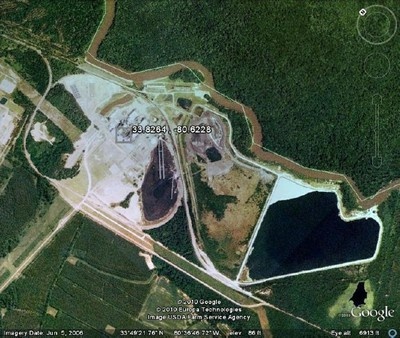A win for clean water in South Carolina coal ash storage lawsuit

A clean-water advocacy group has reached a settlement with South Carolina Electric & Gas (SCE&G) in a lawsuit over storage of toxic coal ash at its Wateree power plant in Eastover, S.C.
Yesterday the Catawba Riverkeeper announced the agreement in an action brought by the Southern Environmental Law Center. It will require SCE&G to remove all of the coal ash -- the toxin-laden waste produced from burning coal for electricity -- from unlined impoundments adjacent to the Wateree River and either recycle it or move it into lined landfills away from the river. The settlement also speeds up the schedule for the complete removal of coal ash from the plant's impoundments (in photo), with that work now set to be complete in eight years.
Rick Gaskins, the Catawba Riverkeeper, called the agreement "a major step forward for the protection of the Catawba-Wateree basin." Jim Landreth, vice president for SCE&G's fossil operations, said the settlement is "a great example of how industry, stakeholders and government agencies can work together to produce a proactive plan that is in the best interest of all."
Known as the Catawba from its headwaters in North Carolina's Blue Ridge Mountains until it reaches Lake Wateree in Kershaw County, S.C., the Wateree eventually joins the Congaree to form the Santee, which empties into the Atlantic south of Georgetown, S.C. The Wateree Station is the largest fossil plant in SCE&G's system, generating over 700 megawatts of electricity in its two generation units. South Carolina-based SCANA is SCE&G's parent company.
In 2001, the S.C. Department of Health and Environmental Control (DHEC) cited the Wateree plant for violations of state groundwater standards but didn't take any further regulatory action. In 2009, runoff containing high levels of cancer-causing arsenic was found to be seeping from an impoundment there, contaminating groundwater and running into the Wateree River. Groundwater monitoring around the plant's coal ash impoundments found arsenic at 18 times the safe limits set by the Safe Drinking Water Act; arsenic was also found to be accumulating in organisms living in the river.
Environmental advocates sued SCE&G earlier this year, charging that a 2011 agreement between SCE&G and the DHEC to address pollution discharges at the plant was not binding. The settlement makes that agreement binding.
The disastrous collapse of a coal ash impoundment at the Tennessee Valley Authority's Kingston plant in eastern Tennessee in 2008 brought the problem of coal ash storage to public attention and heightened longstanding concerns about the lack of federal regulations, which are still not in place.
In 2010, the U.S. Environmental Protection Agency proposed two options for more effective oversight -- one a stricter federal regulatory approach, and the other setting broad standards but leaving oversight largely up to the states. Electric utilities and other coal ash interests lobbied hard against the stricter regulations, stalling action by the EPA and leading to numerous congressional efforts to scuttle federal rules that would treat coal ash like other hazardous waste.
Most recently, a provision sponsored by Rep. David McKinley (R-W.Va.) to strip EPA of the authority to regulate coal ash was tacked onto a federal transportation bill. However, environmental advocates succeeded in getting the provision stricken from the bill.
(Google Earth image of the Wateree plant's coal ash impoundments via the Catawba Riverkeeper's website.)
Tags
Sue Sturgis
Sue is the former editorial director of Facing South and the Institute for Southern Studies.
